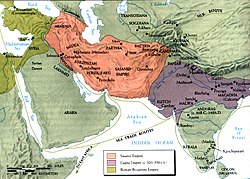Gupta Empire
This article does not have any sources. (October 2023) |
The Gupta Empire was ruled by members of the Gupta dynasty from around 320 to 550 AD and covered most of North-central India and Eastern Pakistan. The time of the Gupta Empire is reffered to as Golden Age of science, mathematics, astronomy, religion and philosophy in South Asia. The kings of this dynasty favour Hinduism and Buddhism.

The Guptas most probably came from Bengal. At the beginning of the 4th century the Guptas ruled a few small Hindu kingdoms in Magadha and around modern-day Uttar Pradesh.
We get plenty of information about this dynasty through coins, inscriptions, monuments, and Sanskrit writings. The Gupta rulers were great conquerors and good administrators. This brought on a series of invasions that weakened the empire, but many of their cultural and intellectual achievements were saved and transmitted to other cultures and live on today. Fa Hien visited India during the reign of Chandragupta II and stayed in this country for several years.
People lived a simple life. Commodities were affordable and all round prosperity ensured that their requirements were met easily. They preferred vegetarianism and shunned alcoholic beverages. Gold and silver coins were issued in great numbers which is a general indicative of the health of the economy. Trade and commerce flourished both within the country and outside. Silk, cotton, spices, medicine, priceless gemstones, pearl, precious metal and steel were exported by sea.
Gupta dynasty change
The Gupta dynasty ruled by the Gupta Empire of South Asia, from around 320 to 550.
Some of its main rulers were:
- Chandragupta
- Samudragupta
- Ramagupta
- Chandragupta II
- Kumaragupta I
- Skandagupta
- Narasimhagupta
- Buddhagupta
- Purugupta
- Vishnugupta
- Pushpak
Coins change
The Guptas were the first to introduce a coinage across their empire.This showed both their wealth-as some coins were trying to unify the empire by using the same coins over the empire.
Further reading change
- Karls, Farah. World History The Human Experience.
| Preceded by Kanva dynasty |
Magadha dynasties 240-550 AD |
Succeeded by Pala dynasty |
Other websites change
- Frontline Article on Gupta Period Art Archived 2008-12-04 at the Wayback Machine